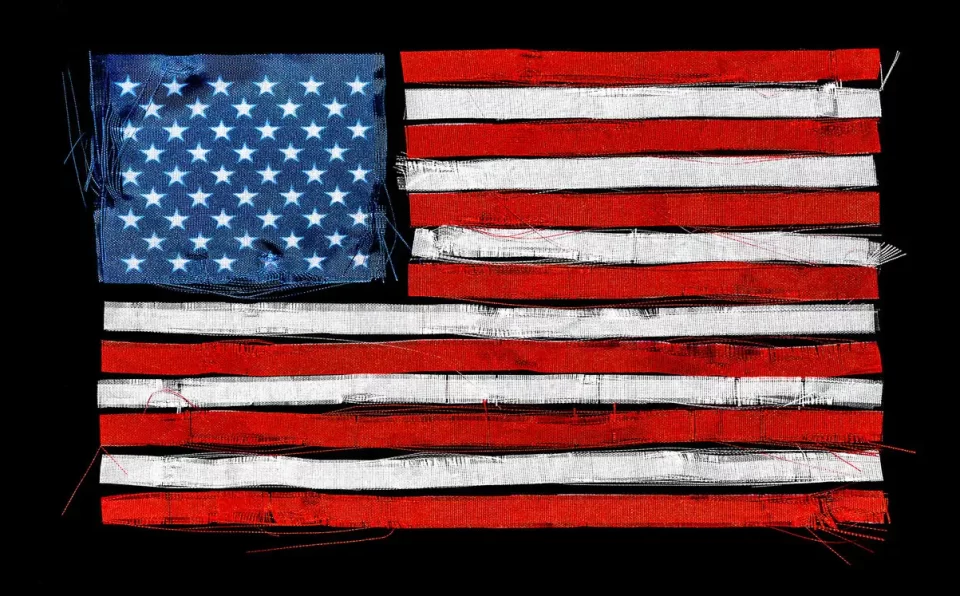Reports Multiply on What Else Might Be in Store
Black Editor Leaves After White Woman’s Promotion
U.N. Warns of ‘Unprecedented Food Crisis’ in Africa
Houston Chronicle Apologizes for Racist Editorials
Worldwide, Newsrooms Lack Clear Diversity Plans
NAHJ Picks Its COO as Executive Director
Reuters Journalist Killed by Israeli Shelling
50 Cent Making Film on ‘Diddy’ After Sex Charges
Maria Martin, ‘Latino USA’ Creator, Dies at 72
Group Wins Fight to Know Locations of Tribal Jails
Lear Influenced Public Image of Black People
‘We apologize for editorials on Houston’s deadly 1917 riot’
Short Takes: Alejandra Matos; Joy Sewing; Amy Robach and T.J. Holmes; Jesus Rodriguez and Washington Post one-day strike; Brittney Griner; community reporters at CBS News stations; Graham Lee Brewer and Terry Tang; Boston’s Charles Stuart case; Antonia Hylton; Washington Post spotlight of African press-freedom case; Lydia Polgreen and Committee to Protect Journalists; re-examining 1983 U.S. invasion of Grenada; rebels occupying Sudan broadcast offices; sit-in on Journalist’s Day in Guatemala; Burkina Faso suspends Le Monde.
Homepage photo: Photo illustration for New York Times series “Democracy Challenged.” Credit: Matt Chase
Support Journal-isms
Comedian Roy Wood Jr., left, and members of the White House Correspondents’ Association last spring at the organization’s annual dinner. The Trump era marked the first time the sitting president, who had called the press the “enemy of the people,” had not attended since a recovering Ronald Reagan was absent in 1981. Reagan had been shot. (Credit: White House Correspondents’ Association)
Reports Multiply on What Else Might Be in Store
As news outlets step up efforts to report on Donald Trump’s plans to move the United States in an unprecedented shift toward autocracy, a Trump ally who worked in his Justice Department said a second Trump administration would retaliate against people in the media “criminally or civilly,” Michelle L. Price reported for the Associated Press.
“Kash Patel, who was also chief of staff in the Defense Department and held a role on the National Security Council, made the comment on Steve Bannon’s podcast. He said that, in a second Trump administration, ‘We will go out and find the conspirators not just in government, but in the media,’ over the 2020 election, which Trump lost to Democrat Joe Biden.”
The same Tuesday, Trump said “that he would not be a dictator upon returning to office ‘except for Day One,‘ as he largely deflected questions at a televised town hall event about whether he would abuse his powers to seek retribution against his political adversaries,” Mariana Alfaro reported for The Washington Post.
 On NPR Friday, co-host Mary Louise Kelly asked Martin Baron (pictured), former editor of The Washington Post, “There’s so much discussion these days, as you know, over whether democracy is on the line in next year’s election. Do you believe it is?”
On NPR Friday, co-host Mary Louise Kelly asked Martin Baron (pictured), former editor of The Washington Post, “There’s so much discussion these days, as you know, over whether democracy is on the line in next year’s election. Do you believe it is?”
Baron responded, “Yes, I absolutely do believe it is. All you have to do is listen to what Donald Trump has been talking about, what he says he’s going to do in another administration. He’s the only politician I’ve heard actually talk about suspending the Constitution.
“He’s talked about using the military to suppress entirely legitimate protests using the Insurrection Act. He’s talked about bringing treason charges against the then-outgoing chairman of the Joint Chiefs of Staff. He’s talked about bringing treason charges against Comcast, the owner of NBC and MSNBC. He’s talked explicitly about weaponizing the government against his political enemies. And, of course, he continues to talk about crushing an independent press. So all of those, by nature, by definition, are authoritarian in nature.”
Baron added, “We need to explain what a second Trump administration would look like. I think that is the task of people on the opinion pages. I think that’s the task of reporters as well. . . . I don’t think we have an alternative, except to tell the American public what it might be in for — what it’s likely to be in for if Trump were to be reelected.”
Sophia Cai of Axios explained in May: “In public statements, videos and posts on his campaign’s website, Trump complains about Washington’s ‘swamp’ — but lays out a plan that would give him, as president, more control of virtually every facet of life in America.”
In Nieman Lab’s predictions for 2024, media writer Brian Stelter wrote this week, “Think ahead to the fall of 2024. The Republican party nominee for president pledges that his administration will open investigations into media companies that make statements his voters don’t like to hear. This nominee has a very real chance of winning the election. And he has promised to act not on his own impulses, not on his own delusions, but on the tear-it-all-down demands of his supporters. ‘I am your retribution,’ he says.
“How should the owners of the targeted media companies react? How will they?

“Hopefully, board members, CEOs, and chief communications officers are already thinking through these questions. The threats from Donald Trump and his allies are not going to dissipate. Trump is redefining normal news coverage as ‘election interference’ and ‘illegal political activity.’ He is telling his fans that the government should intervene and make the parent companies of these outlets ‘pay.’ He is calling out CEOs by name. . . .”
On Friday, The Atlantic announced a special January/February issue, “If Trump Wins.” “A second Trump presidency won’t just mirror the first,” a news release said. “It will be much worse. In The Atlantic’s January/February issue, two dozen writers warn what could happen if Donald Trump is reelected, from destroying the rule of law to abandoning NATO and reshaping the international order.”
Last month, the Washington Post’s Isaac Arnsdorf, Josh Dawsey and Devlin Barrett broke the story that “Donald Trump and his allies have begun mapping out specific plans for using the federal government to punish critics and opponents should he win a second term, with the former president naming individuals he wants to investigate or prosecute and his associates drafting plans to potentially invoke the Insurrection Act on his first day in office to allow him to deploy the military against civil demonstrations.”
As Baron referenced, “Much of the planning for a second term has been unofficially outsourced to a partnership of right-wing think tanks in Washington. Dubbed ‘Project 2025,’ the group is developing a plan, to include draft executive orders, that would deploy the military domestically under the Insurrection Act, according to a person involved in those conversations and internal communications reviewed by The Washington Post. The law, last updated in 1871, authorizes the president to deploy the military for domestic law enforcement.”
In 2022, The New York Times began a series, “Democracy Challenged,” which took a global view of rising authoritarianism. In an early piece, David Leonhardt cited two threats to American democracy. Of the first, he quoted Yascha Mounk, a political scientist at Johns Hopkins University who studies democracy. “There is the possibility, for the first time in American history, that a legitimately elected president will not be able to take office.”
Leonhardt continued, “The second threat to democracy is chronic but also growing: The power to set government policy is becoming increasingly disconnected from public opinion.”
A second Times series, “How Trump and His Allies Plan to Wield Power in 2025,” began Monday. The subhead: “Donald J. Trump and his allies are already laying the groundwork for a possible second Trump presidency, forging plans for an even more extreme agenda than his first term.”
If there were any doubt on whose behalf Trump would be working, author and political journalist Tim Alberta said on the “PBS NewsHour” this week that it wouldn’t be people of color.
Tim Alberta tells the “PBS NewsHour’s” Geoff Bennett that white evangelical Christians feel beleaguered and look to Donald Trump “to do the dirty work for them.” (Credit: PBS/YouTube)
“It’s important to sort of hone in on this idea that, for the white Christian in America, they are now losing status in ways that they have never seen before, that, if you look, just statistically and demographically, 50 years ago, during the heyday of the Moral Majority, this was fundamentally a different country then than it is today,” Alberta told co-anchor Geoff Bennett.
“And, in some sense, it takes someone like Donald Trump, who’s not a Christian. . . ., he’s not beholden to Christian values, and, therefore, it makes him almost this mercenary who’s willing to fight on behalf of this beleaguered population who feels under siege, and they have turned to someone like Donald Trump to do the dirty work for them.”
In the Nieman Lab issue on predications for 2024, Matt DeRienzo, editor-in-chief of the Center for Public Integrity, looked at these developments from a different angle.
“It’s about a demographic shift that will put non-Hispanic white Americans in the minority, and how they maintain their grip on power. More acutely, it’s about issues like corporate economic interests and assaults against the bodily autonomy of women that face deep opposition from a majority of Americans across the country.
“The only way to put these policies into law and practice is to prevent enough people who oppose them from voting, to gerrymander the power of their vote into oblivion, to make it impossible for them to go directly to voters with a referendum in the face of that gerrymandering. . . .
“Access to voting and political representation is deeply unequal in all 50 states. This attack on the fundamental pillars of a multiracial American democracy will make it the central focus of journalists’ coverage of the 2024 election.”
- Mike Allen and Jim VandeHei, Axios: Behind the Curtain — Exclusive: How Trump would build his loyalty-first Cabinet
- Jon Allsop, Columbia Journalism Review: How did we cover threats to democracy in 2023? (Dec. 11)
- Perry Bacon Jr., Washington Post: We need less talk about ‘democracy’ and more about our actual disagreements (Nov. 27)
- Phil Boas, Arizona Republic: As Univision cozies up to Trump, the Latino vote is very much in play (Nov. 15, updated Nov. 16)
- Sophia Cai, Axios: Trump’s 2025 vision, revealed (May 21)
- Jamie Gangel, Jeremy Herb and Elizabeth Stuart, CNN: Exclusive: Liz Cheney’s new book blasts GOP as ‘enablers and collaborators’ of Trump, whom one member called ‘Orange Jesus’
- Jack Herrera, Los Angeles Times: I’m politically neutral as a journalist. Should I be neutral as a Mexican?
- Ruben Navarrette Jr., syndicated: To be a good president, it helps to be a good person
- Ruben Navarrette Jr., syndicated: Trump’s ‘vermin’ attack sounds familiar – in more ways than one (Nov. 21)
- Solomon Jones, Philadelphia Inquirer: Black voters, accustomed to threats, were just dealt a devastating blow (Nov. 30)
- Adam Rawnsley and Asawin Suebsaeng, Rolling Stone: Inside Trump’s Plot to Corrupt the 2024 Election With ‘Garbage’ Data
- Beth Reinhard, Manuel Roig-Franzia and Clara Ence Morse, Washington Post: Trump pardoned them. Now they’re helping him return to power.
- Frances Robles, Ken Bensinger and Jeremy W. Peters, New York Times: Conundrum of Covering Trump Lands at Univision’s Doorstep
- Mary Sanchez, Tribune Content Agency: The Voting Rights Act of 1965 suffers another blow (Nov. 22)
- Kimberly Atkins Stohr, Boston Globe: Conservatives renew their attack on the Voting Rights Act
- Will Sutton, NOLA.com: The Voting Rights Act protects democracy, votes. More need to watch. (Nov. 28)
- Jonathan Swan, Maggie Haberman and Charlie Savage, New York Times: How Trump and His Allies Plan to Wield Power in 2025
- Shelby Talcott and Max Tani, Semafor: NBC News demands Trump campaign take down fake clip of reporter
- Juan Williams, The Hill: Don’t be duped by Trump’s claims of Black support
- Philip Bump, Washington Post: New research undercuts Republican views of racism

Black Editor Leaves After White Woman’s Promotion
A longtime editor of the New York Amsterdam News, one of the nation’s most prominent Black weeklies, has left the organization because a white woman was named the company’s president, the editor, Nayaba Arinde, messaged Journal-isms on Friday.
“I will just say that they’ve hired a new president of the company who happens to be of European descent, and I believe they are moving in a different direction. My focus when working for the Black press, has always been on reporting news from the Black perspective.
“Even when I am working for mainstream media when writing on Black issues, I do so from an unapologetically Black viewpoint.”
Elinor Tatum told Journal-isms that she remains publisher and editor in chief of the newspaper and CEO of the company. She named the new president: “Siobhan Bennett, who has been at the company since July 2021 and was recently promoted to President of the company. President is a business and HR function at the Amsterdam News. She is indeed of European descent,” Tatum messaged.
 Bennett (pictured) was formerly the company’s revenue officer.
Bennett (pictured) was formerly the company’s revenue officer.
Arinde wrote on LinkedIn, “After 18 years, I have left my position as the Editor of the New York Amsterdam News. As . . . I consider a variety of really exciting options, I continue to host my radio show and podcast called Back to Basics on Inceptionfm.com and YouTube.
“I am an experienced editor, writer, radio host and producer in both England and America for over 30 years. . . .”
The Amsterdam News is advertising for a news editor.
Though Bennett is assuming a business-side position, there have been white editors at Black publications. Ben Burns, who died at 86 in 2000, spent most of his career at Black outlets. Burns wrote a book, “Nitty Gritty: A White Editor in Black Journalism,” that included heavy references to his experiences at the Chicago Defender and at Jet magazine. Burns reported that he found himself too radical for the Black press. More examples in this 2003 column.
On the other hand, in 2012, Michael Bullerdick was removed as the managing editor of Essence, the Black women’s magazine then owned by Time Warner, after less than a year in the position.
Though the magazine emphasized that Bullerdick had a production, not an editorial role, right-wing material on his Facebook page was brought to the editors’ attention. His removal soon followed.
U.N. Warns of ‘Unprecedented Food Crisis’ in Africa
“At least three-fourths of Africans can’t afford a healthy diet, and a fifth are undernourished due to an “unprecedented food crisis,” United Nations agencies said in a report released Thursday with the African Union Commission,” Chinedu Asudu reported for the Associated Press.
 “The continent’s 1.4 billion people are confronting high levels of hunger and malnutrition as the hit on world grain supplies from Russia’s war in Ukraine compounds the ills of African conflicts, climate change and the aftereffects of the COVID-19 pandemic, the report said.
“The continent’s 1.4 billion people are confronting high levels of hunger and malnutrition as the hit on world grain supplies from Russia’s war in Ukraine compounds the ills of African conflicts, climate change and the aftereffects of the COVID-19 pandemic, the report said.
“It warned that ‘millions are expected to be at risk of worsening hunger in the near future.’
“With a young population set to double by 2050, Africa is the only rapidly growing region where people are getting poorer, and some are beginning to celebrate coups by soldiers who promise a better life. Despite its wealth of natural resources, Africa is far from meeting its commitment to end hunger and all forms of malnutrition by 2025. . . .”
Houston Chronicle Apologizes for Racist Editorials
The Houston Chronicle apologized Sunday for its role in the deadly events of 1917, including a riot that led to the deaths of 16 white people, including five officers, and four Black soldiers.
“Last month, the U.S. military attempted to make amends, overturning the convictions of 110 soldiers in a somber ceremony at the Buffalo Soldiers National Museum on Caroline Street. We wrote then that more entities should follow their lead and atone for historic wrongs,” an editorial said.
“Now, it’s our turn.
“The day after the riot, in a front-page editorial, the Houston Chronicle beat the drum for military authorities to ‘act with vigor and determination,’arguing that there was no need for ‘finespun litigation’ and that all the soldiers should be tried together. Set in all caps: ‘A COURT MARTIAL, A HOLLOW SQUARE AND A FIRING SQUAD WILL SETTLE THE MATTER ONCE AND FOR ALL.’
“Reading these words today is a chilling reminder of the deeply entrenched role of racism in Houston’s past, including in this publication. Through a series of at least nine pieces in the month after the riot, Chronicle editorials used the violence and trial as an opportunity to excuse Houston’s ‘customs’ — and encourage a reckless conviction not unlike the mob violence they sought to condemn.”
The full editorial is republished at the end of this column.

Worldwide, Newsrooms Lack Clear Diversity Plans
“Newsrooms lack a structured and clear plan for diversity,” Federica Cherubini and Ramaa Sharma reported Tuesday for the Reuters Institute, disclosing the results of a survey of 135 senior industry leaders from 40 countries and 10 in-depth interviews.
“Of the survey participants, 43% said their organisation has a systematic and articulated strategy for diversifying talent acquisition, but in other areas systematic strategies were relatively rare.
“When looking at retaining talent, only 22% of news leaders said their organisations have a systematic and articulated strategy and 37% have such an approach to reflecting diversity in stories produced.
“When we asked news leaders who participated in the survey what challenges they thought their organisations were encountering when trying to improve diversity and representation, finding diverse talent was identified as the top challenge, mentioned by 57% of our respondents. In addition, 29% said retaining diverse talent was a problem, 20% said that improving diversity and representation is not considered an organisational priority, and 17% said there is a lack of understanding of the value/merit of it. . . . “
- Sam Kille, Report for America: Report for America adds newsrooms, opens applications for reporters
- Reuters Institute: Race and leadership in the news media 2023: evidence from five markets (March 21)
NAHJ Picks Its COO as Executive Director
 Yaneth Guillen-Diaz (pictured), chief operations officer and longest-serving staff member of the National Association of Hispanic Journalists, was named its executive director, the association announced Monday, “taking the helm of the 3,600-member journalism nonprofit as it embarks on its milestone 40th anniversary year in 2024.“
Yaneth Guillen-Diaz (pictured), chief operations officer and longest-serving staff member of the National Association of Hispanic Journalists, was named its executive director, the association announced Monday, “taking the helm of the 3,600-member journalism nonprofit as it embarks on its milestone 40th anniversary year in 2024.“
The announcement also said, “Prior to serving as COO, Guillen-Diaz was NAHJ’s Senior Director of Training & Membership, designing, planning, and implementing training programs for professional members, many through industry partnerships. In that role, she oversaw more than 20 professional chapters across the country, as well as developing programs to expand the organization’s membership. . . .
“NAHJ aims to raise $250,000 to support its training, scholarships, and advocacy work ahead of the 40th anniversary conference, which will be held July 9-13, 2024 in Hollywood, Calif.”
NAHJ was to partner with the National Association of Black Journalists for a joint 2024 convention in Chicago, but NAHJ pulled out, saying it wanted to commemorate its anniversary separately. Neither group has said what penalties, if any, must be paid for the change in location.
Financial Officer Geraldine Cols Azócar said at the NAHJ board’s Nov. 11 meeting that the association is falling behind budget projections because “we didn’t get as many grants as we originally planned.” She also cited the mid-year departure of Executive Director David Peña.
However, Cols Azócar emphasized, “This does not mean that NAHJ is in the red.” The association is in “one of the best financial positions we’ve had in years.”
Guillen-Diaz said then that the organization had 3,647 active paid members, of which 1,000 are student members.
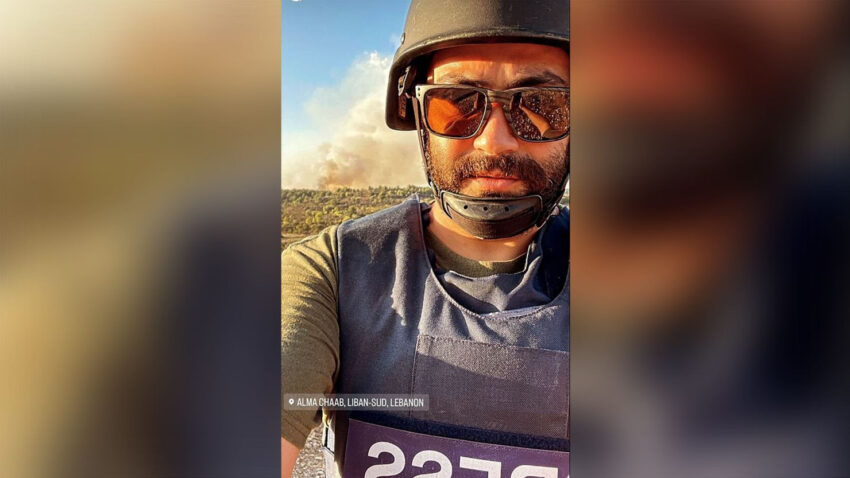
Reuters Journalist Killed by Israeli Shelling
“Investigations by two news organizations and two human rights groups made public on Thursday say that it was Israeli tank shells that in October killed Reuters videographer Issam Abdallah and injured six other journalists in southern Lebanon,” Tamara Qiblawi, Mia Alberti and Allegra Goodwin reported Thursday for CNN.
“The reports by Reuters, AFP, Amnesty International, and Human Rights Watch drew on forensic analysis, witness testimony and interviews with government officials, lawyers and medical professionals.
“The findings are in line with a CNN analysis of the events conducted at the time. A CNN team that was nearby in southern Lebanon reported at the time that the projectile that hit the journalists October 13 came from Israel.
“CNN has asked the Israel Defense Forces (IDF) for comment on the allegations.
“Eylon Levy, a spokesperson for the Israeli government, said Thursday that he was ‘not familiar’ with the new reports. ‘The guiding principle in Israel’s campaign against Hamas is we uphold the principles of international law regarding proportionality, necessity, distinction,’ he said. ‘We target Hamas, we do not target civilians.’ . . .
“IDF spokesperson Richard Hecht on October 14 called Abdallah’s death [a] ‘ tragic thing,’ without naming him directly or acknowledging Israel’s involvement. The same day, the IDF said: ‘A report was received that during the incident, journalists were injured in the area. The incident is under review.’ ”
- Marina Adami, Reuters Institute: Breaks, grief and community: how to protect yourself when sifting through graphic visuals from Gaza and beyond (Nov. 17)
- Lama Al-Arian, New York Times: Over 60 Journalists Have Been Killed in the Israel-Gaza War. My Friend Was One.
- Committee to Protect Journalists: CPJ calls for release of Al-Araby Al-Jadeed Gaza correspondent Diaa Al-Kahlout
- Committee to Protect Journalists: CPJ calls for accountability after reports find Israel likely targeted journalists in Lebanon
- Committee to Protect Journalists: Map of journalists killed in Palestine/Israel (scroll down)
- Ingrid Jacques, USA Today: Hamas terrorists raped and mutilated Israeli women and girls. Where are #MeToo warriors?
- Ivana Kottasová, CNN: What we know about rape and sexual violence inflicted by Hamas during its terror attack on Israel
- Pew Research Center: Americans’ Views of the Israel-Hamas War
Lisa Rozner of WCBS-TV in New York reports on the latest allegations against rapper Sean Combs, also known as P. Diddy. The fifth lawsuit in the last month was filed against him Wednesday. (Credit: WCBS/YouTube)
50 Cent Making Film on ‘Diddy’ After Sex Charges
“50 Cent‘s production company will be releasing a documentary about Sean ‘Diddy’ Combs and the sexual assault allegations pointed against him,” Thania Garcia reported Thursday for Variety.
“After the news of a fourth allegation of sexual assault against Combs [PDF] was revealed, 50 Cent announced via X (formerly Twitter) on Thursday that proceeds from his upcoming documentary about Combs will go to victims of sexual violence. G-Unit Film & Television will be producing the untitled film.
” ‘Proceeds from this Documentary will go to victims of Sexual Assault and Rape,’ 50 wrote on X along with a clip of the documentary. In the footage, former Bad Boy Records rapper Mark Curry described the dangerous party scenes allegedly encouraged by Combs and his entourage, specifically recalling how . . . Combs would spike bottles of champagne at his parties for women to drink from. Curry said the women were not aware they were being drugged and became ‘real, real slippery.’ . . .”
Filmmaker dream hampton’s 2019 Lifetime docuseries “Surviving R. Kelly,” and its follow-up, 2020’s “Surviving R. Kelly Part II: The Reckoning,” have been credited with marking “the end to years of Kelly operating with impunity.” Kelly is serving 30 years in prison after his conviction of racketeering and sex crimes.
- Rashad Grove, BET: R. Kelly Sues US Prison Bureau For Allegedly Leaking Private Info to YouTube Host Tasha K (Nov. 16)
- Gene Maddaus, Variety: Sean ‘Diddy’ Combs Accused of Gang-Rape of 17-Year-Old Girl
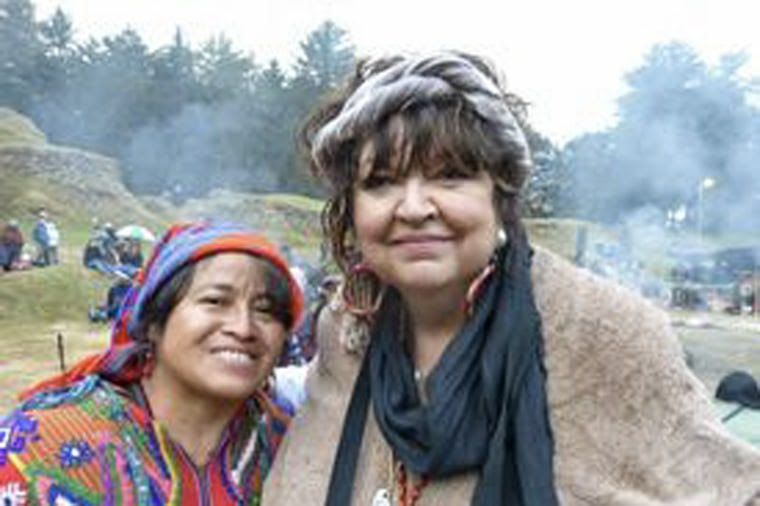
Maria Martin, ‘Latino USA’ Creator, Dies at 72
“Media pioneer Maria Martin, creator of the groundbreaking, award-winning public radio program ‘Latino USA,’ died Saturday after complications from a medical procedure,” Suzanne Gamboa reported Dec. 3 for NBC News. “She was 72.
“Martin dedicated much of her professional life to bringing the voices and stories of U.S. Latinos and Latin Americans to English-language public radio. In doing so, she helped inspire and launch the careers of a cadre of Latino journalists in the U.S. and Central America.
“Friends and family said in [a] message that she died ‘in a room full of peace and love surrounded by her family’ and her friends ‘at every corner of the world holding her up.’
“Martin’s long ambition had been to bring diversity to media, public radio in particular, a goal that brought her both joy and heartache, but which she never abandoned.
” ‘The values of inclusivity, diversity and the reflection of all society’s voices have guided my four decades in journalism,’ she wrote in her 2020 book ‘Crossing Borders, Building Bridges: A Journalist’s Heart in Latin America,’ which chronicled her work as a journalist in Latin America, but also the obstacles and challenges she faced and overcame as a Latina journalist.
“Martin, who was of Mexican and Irish descent, broke many barriers, many of which went unrecognized until recently . . . .”
“Latino USA” paid tribute to Martin by replaying the first special episode marking the show’s 30 years on the air. “The episode, first aired in May 2023, is an oral history of Latino USA and features a conversation between Martin and our current co-executive producer Maria Hinojosa, whom Martin chose to be the host of Latino USA back in 1993.”
- Peniley RamÍez and Maria Hinojosa, “Latino USA”: Latino USA Founder and Pioneering Radio Journalist María Martin Passes Away in Texas

Group Wins Fight to Know Locations of Tribal Jails
“Today, Grist is making a dataset on tribal jails in the United States available to journalists and the public after a hard-fought records battle,” the organization, “a nonprofit, independent media organization dedicated to telling stories of climate solutions and a just future,” said Nov. 30.
“Earlier this year, Grist published an investigation into the disproportionate threat that extreme heat poses to incarcerated populations in detention facilities run by tribal nations or the Bureau of Indian Affairs, or BIA.
“As part of the project, our reporters sent Freedom of Information Act requests to determine the locations of 81 tribal jail facilities. The Bureau of Indian Affairs, the agency in charge of those records, refused to release the physical addresses of those jails and detention centers. After multiple requests to the BIA, officials revealed only the towns in which tribal facilities were located, but no street or mailing addresses.
“Grist appealed the agency’s response — and won. We now have the exact locations of all U.S. tribal jails and detention centers, information that, to our knowledge, has never been made public before.”
- Colleen Long, Susan Montoya Bryan and Hallie Golden, Associated Press: At tribal summit, Biden says he’s working to ‘heal the wrongs of the past’ and ‘move forward’
NPR critic Eric Deggans is interviewed Saturday by Christian Bryant, host of “Scripps News Tonight” on Scripps News TV. They discussed Norman’s Lear’s legacy and his conflicts with Black actors and writers. (Credit: YouTube)
Lear Influenced Public Image of Black People
“At five, I was banned from watching ‘Sanford & Son’ after I slapped a toy out of my cousin’s hands, rolled my eyes, called him a fish-eyed fool and a heathen in my best Aunt Esther imitation,” Elizabeth Wellington wrote Wednesday for the Philadelphia Inquirer, discussing the legacy of legendary television producer Norman Lear, who died at 101 on Tuesday.
“That was the power of Norman Lear’s situation comedies on my little pop-culture psyche back in the 1970s and 1980s, when Lear’s shows dominated the prime-time landscape. With shows like Maude and All in The Family, Lear introduced taboo topics like rape, incest, and abortion to America’s living rooms in a way that educated us and made us laugh. . . .
“Lear’s impact on the Black situation comedy was groundbreaking. From The Jeffersons’ to Good Times, Lear introduced modern Black life to television, when before we just had Soul Train. Little Black children saw ourselves in Arnold, Willis, Tootie and Michael. Songs in these shows’ opening credits were schoolyard chants. Lear proved that Black shows starring Black people had a place on primetime television, paving the way for a slew of 1990s comedies from ‘Martin’ to ‘Moesha.’ “
Wellington also wrote, “Lear was aware and proud of his impact on Black television. In 2016, he said in an MSNBC news article that through his work white audiences learned ‘what a Black family was like. Without understanding it, they were growing to accept and understand differently the Black family in their lives.’ ”
NPR television critic Eric Deggans noted, however, that many Black people were not happy with the “J.J.” character on “Good Times.”
Deggans told Christian Bryant of Scripps TV that the show’s stars, Esther Rolle and John Amos, would be asked by Black people (video), “Why is the show focused on this more stereotypical character instead of some of the other, more uplifting characters? So there was a natural tension there that sometimes resulted in disagreements and ultimately resulted in John and Esther leaving the show.”
Still, the New York Times’ Jonathan Abrams and Christopher Kuo quoted Tyler Perry, the Black film and television entrepreneur, Saturday saying that “Had it not been for Norman, there wouldn’t have been a path for me. It was him bringing Black people to television and showing the world that there’s an audience for us.”
Abrams and Kuo added, “it’s hard to find anyone in the medium of television who is held in such high regard, including by many Black writers and showrunners now creating and running today’s shows.”
- Kenya Barris as told to Lacey Rose, Hollywood Reporter: Kenya Barris Remembers Mentor Norman Lear: “He Made Other People See Me” (Dec. 13)
- Clarence Page, Chicago Tribune: Norman Lear’s comedy helped diverse Americans tune in to each other (Dec. 12)
Short Takes
 “Alejandra Matos (pictured) has been named the Houston Chronicle’s managing editor for audience and content strategy. She is the first Latina to hold the role and to appear on the news organization’s masthead,” the Chronicle reported Wednesday. ” ‘Alejandra brings high-level strategy, digital leadership and a sharp sense of how to connect with audiences in Houston and beyond,’ said Kelly Ann Scott, the Chronicle’s editor-in-chief. . . . In her role, Matos will oversee the newsroom’s audience development teams as well as statewide content initiatives including a nine-person Austin bureau covering state government and politics, a statewide weather team and data team. . . .”
“Alejandra Matos (pictured) has been named the Houston Chronicle’s managing editor for audience and content strategy. She is the first Latina to hold the role and to appear on the news organization’s masthead,” the Chronicle reported Wednesday. ” ‘Alejandra brings high-level strategy, digital leadership and a sharp sense of how to connect with audiences in Houston and beyond,’ said Kelly Ann Scott, the Chronicle’s editor-in-chief. . . . In her role, Matos will oversee the newsroom’s audience development teams as well as statewide content initiatives including a nine-person Austin bureau covering state government and politics, a statewide weather team and data team. . . .”
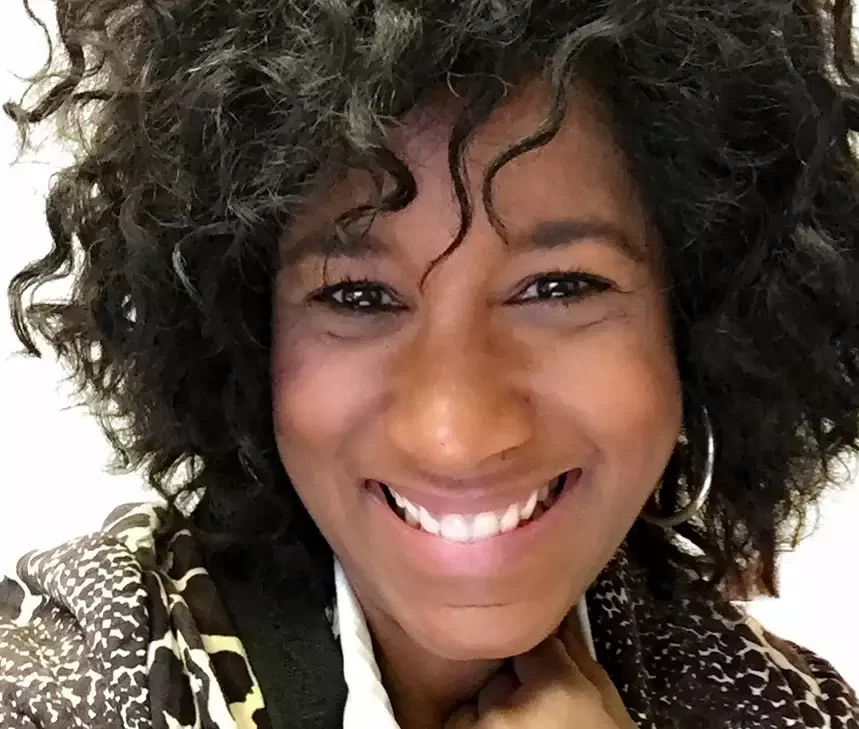 “Joy Sewing, a Houston native and veteran journalist, is taking on a new role as a news columnist,” the Houston Chronicle announced Friday. “Chronicle readers have come to know Sewing for her takes on people – especially people of color – and cultural topics that make our city tick. Sewing will be the first Black news columnist in the Chronicle’s 122-year history.” Sewing has been writing a local, human-interest column and reporting. The new job moves her to the “A” section.
“Joy Sewing, a Houston native and veteran journalist, is taking on a new role as a news columnist,” the Houston Chronicle announced Friday. “Chronicle readers have come to know Sewing for her takes on people – especially people of color – and cultural topics that make our city tick. Sewing will be the first Black news columnist in the Chronicle’s 122-year history.” Sewing has been writing a local, human-interest column and reporting. The new job moves her to the “A” section.
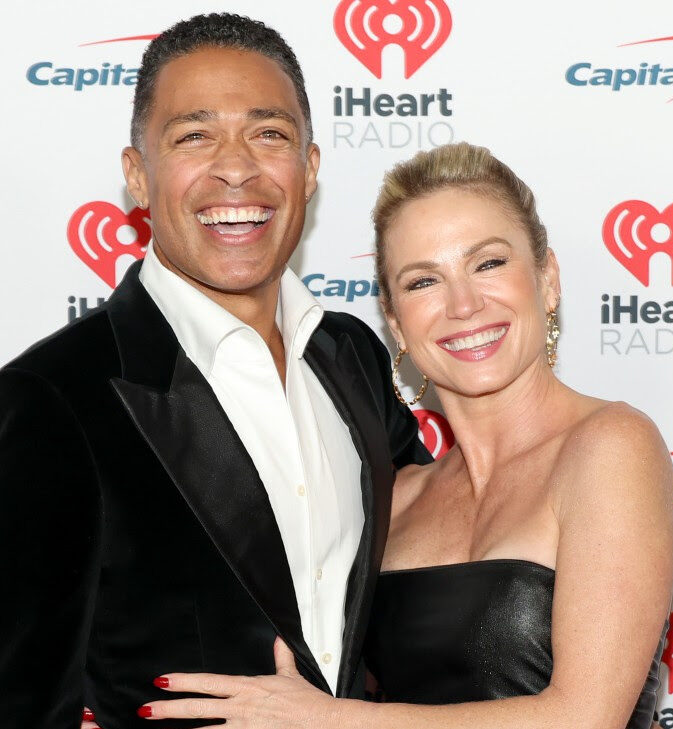 “A year to the day after they were first suspended by ABC News following the public disclosure of their personal relationship, Amy Robach and T.J. Holmes (pictured) are speaking out about what happened,” Alex Weprin reported Tuesday in the Hollywood Reporter. “The pair discussed their relationship and subsequent departure from ABC on the first episode of their new iHeartMedia podcast, called Amy & T.J. . . Robach said that their plan was to finalize their divorces, and then tell ABC management and the public that they were a couple, but that [a] tabloid report forced their hand. Holmes added that some of the media coverage framed them as ‘adulterers.’ . . . ”
“A year to the day after they were first suspended by ABC News following the public disclosure of their personal relationship, Amy Robach and T.J. Holmes (pictured) are speaking out about what happened,” Alex Weprin reported Tuesday in the Hollywood Reporter. “The pair discussed their relationship and subsequent departure from ABC on the first episode of their new iHeartMedia podcast, called Amy & T.J. . . Robach said that their plan was to finalize their divorces, and then tell ABC management and the public that they were a couple, but that [a] tabloid report forced their hand. Holmes added that some of the media coverage framed them as ‘adulterers.’ . . . ”
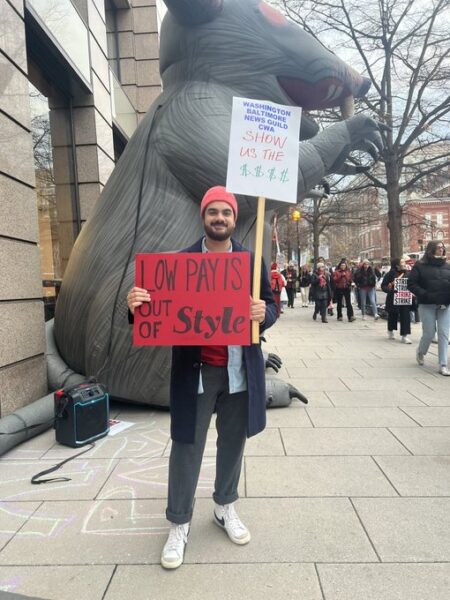
- “I walked off the job today with 750+ of my Washington Post colleagues — we’re asking for higher salary floors, good-faith bargaining, and management decisions that won’t gut our local news coverage,” Jesus Rodriguez, a political features reporter, wrote Thursday on X, formerly Twitter. Keep avoiding Post content until tomorrow, in solidarity with @PostGuild.” Pay equity is among the issues. The Washington Post Guild reported in 2022, “women and people of color are still paid less compared with their male and White colleagues.” Behind Rodriguez is “Scabby the Rat.” “Much like our fight for a fair contract, blowing up Scabby was a long and arduous process but ultimately it is worth the struggle!” Post reporter Rachel Kurzius wrote.
 “Disney wants to get into the Brittney Griner (pictured) business,” Brian Steinberg reported Thursday for Variety. “The inspirational WNBA All-Star, who was arrested and held in Russia in 2022 and sentenced to nine years in prison, will give Disney the exclusive rights to share her story via a documentary feature from ESPN Films, the development of a scripted series through ABC Signature and an exclusive interview with ABC News anchor Robin Roberts. Griner’s wife, Cherelle Griner, will also serve as an executive producer on the projects. . . .”
“Disney wants to get into the Brittney Griner (pictured) business,” Brian Steinberg reported Thursday for Variety. “The inspirational WNBA All-Star, who was arrested and held in Russia in 2022 and sentenced to nine years in prison, will give Disney the exclusive rights to share her story via a documentary feature from ESPN Films, the development of a scripted series through ABC Signature and an exclusive interview with ABC News anchor Robin Roberts. Griner’s wife, Cherelle Griner, will also serve as an executive producer on the projects. . . .”
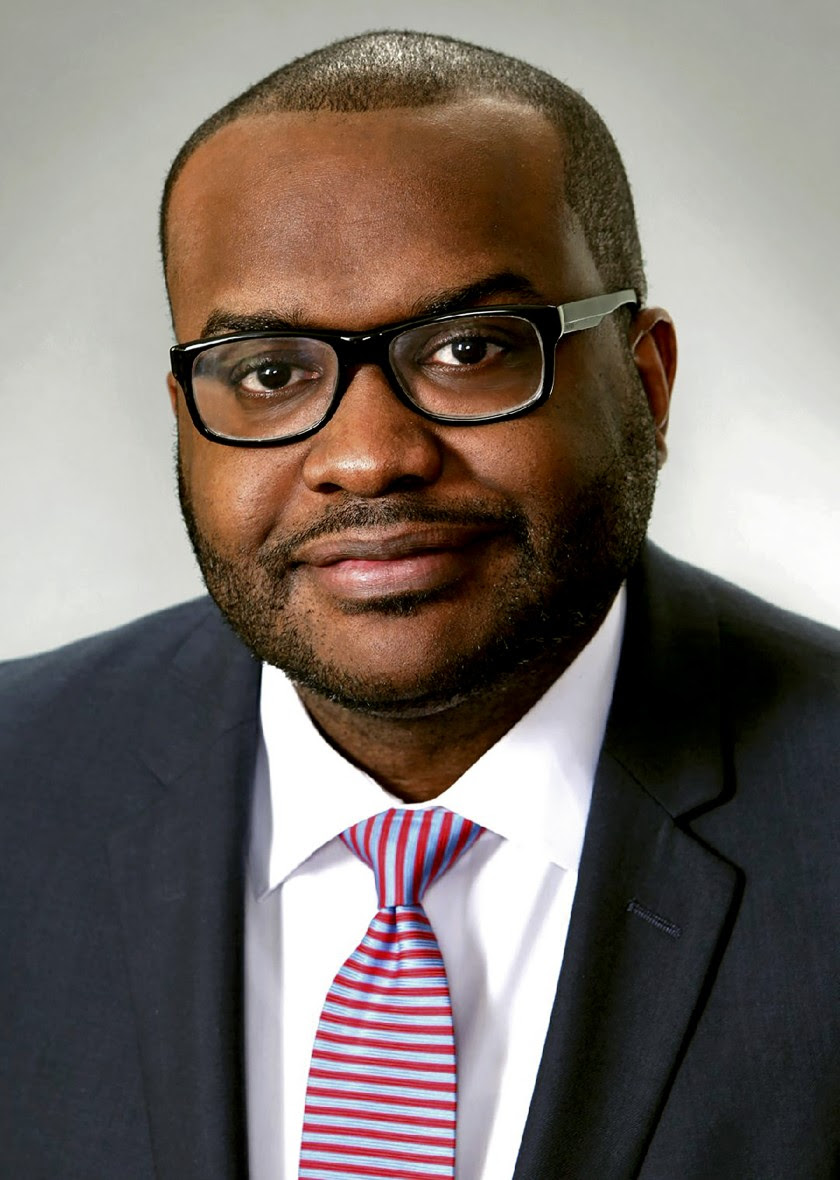 “Community reporters are a growing fixture at CBS News & Stations, where the group has been selectively deploying them to different neighborhoods since Wendy McMahon, the group’s president, took the helm,” Michael Depp reported Dec. 1 for TVNewsCheck. “The premise is straightforward — the reporter develops a closer relationship to the area, building trust and delivering more relevant, useful stories. The community, for its part, sees a station invested in its future. At WCBS in New York, President and GM Johnny Green (pictured) and VP/News Director Sarah Burke say the community reporters are gaining traction with viewers, as are the beat-focused reporters the station is increasingly turning to as well. They say the effort is an investment in trust, especially in a media hostile climate on the cusp of a deeply fraught election year. . . .”
“Community reporters are a growing fixture at CBS News & Stations, where the group has been selectively deploying them to different neighborhoods since Wendy McMahon, the group’s president, took the helm,” Michael Depp reported Dec. 1 for TVNewsCheck. “The premise is straightforward — the reporter develops a closer relationship to the area, building trust and delivering more relevant, useful stories. The community, for its part, sees a station invested in its future. At WCBS in New York, President and GM Johnny Green (pictured) and VP/News Director Sarah Burke say the community reporters are gaining traction with viewers, as are the beat-focused reporters the station is increasingly turning to as well. They say the effort is an investment in trust, especially in a media hostile climate on the cusp of a deeply fraught election year. . . .”
 Graham Lee Brewer, a national investigative reporter for NBC News and former president of what was then the Native American Journalists Association, and Terry Tang (pictured), who “has been among the most consistent contributors to AP’s race news coverage,” have been hired as new Race and Ethnicity reporters at the Associated Press, Race and Ethnicity News Editor Aaron Morrison announced Dec. 1. NAJA has been renamed the Indigenous Journalists Association.
Graham Lee Brewer, a national investigative reporter for NBC News and former president of what was then the Native American Journalists Association, and Terry Tang (pictured), who “has been among the most consistent contributors to AP’s race news coverage,” have been hired as new Race and Ethnicity reporters at the Associated Press, Race and Ethnicity News Editor Aaron Morrison announced Dec. 1. NAJA has been renamed the Indigenous Journalists Association.
- “1989 Boston. Charles Stuart and his pregnant wife, Carol, are carjacked upon leaving a birthing class, drawn deep into the dangerous Mission Hill neighborhood, and allegedly shot by a Black man,” the Boston Globe recalls in a news release. “In a new original podcast and multimedia series a team of Boston Globe investigative journalists — including columnist Adrian Walker, a 30-year Globe veteran who reported on the murder in 1989 — tell the untold story of Mission Hill and the Stuart shooting and expose how the police and the media got it wrong. They spent the last two years reexamining documents, photographs and audio recordings and reinterviewing witnesses, police, prosecutors, politicians and journalists. The crime itself was never really solved, but in their reporting, they uncover evidence that suggests someone else may have been involved in the shooting and they examine whether, in the decades since, anything has changed for Mission Hill, Boston and the nation. . . .”
- “NBC News correspondent Antonia Hylton has revealed that she was diagnosed with a rare type of cancer, a neuroendocrine tumor.” Bruce Haring reported Nov. 30 for Deadline. “The symptoms manifested about two years ago, the 30-year-old Hylton said in a Today interview. She started having stomach issues. . . .The experience has left her with a new perspective, she said. ‘I learned a really important lesson at 30 to listen to myself and to put myself first. I love my job. I worked hard here at NBC, and I’m not going to stop doing that. But I’ve learned the lesson that I really need to put my health first and not push these things off.’ ”
- “The premiere of King Charles on CNN was deemed a ratings flop last week, but Charles Barkley doesn’t subscribe to the numbers,” Brandon Contes reported Thursday for Awful Announcing. “I just want to tell my team, guys, do your best,” Barkley said. “That’s all you do. In anything you do in life, just do your best. Because there are a lot of systems in place that make no sense. The Nielsen’s are at the top of my list. But I really just want to tell my team…I just want to say thank you. And f*** those Nielsen people.”
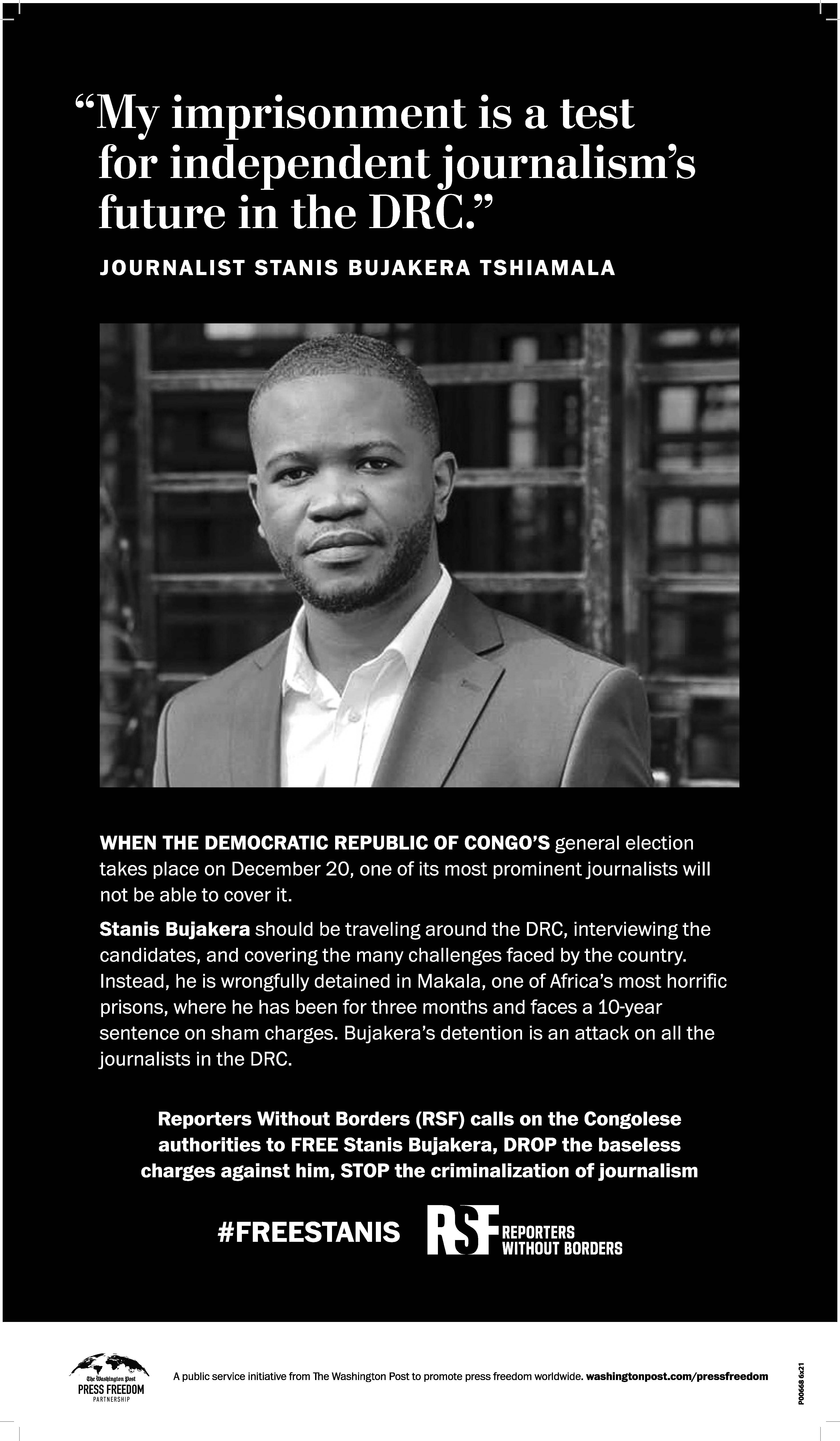
- As part of its press freedom partnership, The Washington Post published a full-page public service ad Friday in support of Stanis Bujakera Tshiamala of the Democratic Republic of Congo. Under the headline, “My imprisonment is a test for independent journalism’s future in the DRC,” the ad says, “When the Democratic Republic of Congo’s general election takes place on Dec. 20, one of its most prominent journalists will not be able to cover it. Stanis Bujakera should be traveling around the DRC, interviewing the candidates and covering the many challenges faced by the country. Instead, he is wrongfully detained in Makala, one of Africa’s most horrific prisons, where he has been for three months and faces a 10-year sentence on sham charges. Bujakera’s detention is an attack on all the journalists in the DRC.”
 “The Committee to Protect Journalists (CPJ) announced on Thursday its new vice chair of the board, Lydia Polgreen (pictured), opinion columnist for The New York Times, and the addition of four leading journalists to its board of directors: Roula Khalaf, editor of the Financial Times; Alan Murray, chief executive officer of Fortune Media; Maria Ressa, co-founder of Rappler, and Jacqueline Simmons, editorial lead of Europe, Middle East, and Africa at Bloomberg. . . .”
“The Committee to Protect Journalists (CPJ) announced on Thursday its new vice chair of the board, Lydia Polgreen (pictured), opinion columnist for The New York Times, and the addition of four leading journalists to its board of directors: Roula Khalaf, editor of the Financial Times; Alan Murray, chief executive officer of Fortune Media; Maria Ressa, co-founder of Rappler, and Jacqueline Simmons, editorial lead of Europe, Middle East, and Africa at Bloomberg. . . .”
- “Six days before the United States invaded the Caribbean island of Grenada in 1983, the murdered body of the country’s beloved prime minister, Maurice Bishop, disappeared,” Rowan Philp wrote Nov. 6 for the Global Investigative Journalism Network. “In a new, six-part podcast, based on a two-year investigation — The Empty Grave of Comrade Bishop — Washington Post podcast host and reporter Martine Powers finds fresh answers about what happened to his remains — and the US government’s role in this enduring mystery. In this exclusive interview, GIJN spoke to Jeff Leen — the head of investigations at The Washington Post for the past 20 years — about the podcast, and how internal collaborations with any staff member or contributor can drive award-winning investigations. . . .” The report was updated Wednesday.

- The Sudanese Journalists Syndicate has denounced the use by the opposition paramilitary group Rapid Support Forces (RSF) “of the buildings of the Sudan Broadcasting Corporation (SBC) as detention centres and the subsequent sale of SBC equipment in Omdurman markets,” the Sudan Tribune reported Thursday. “In a statement, the syndicate affirmed that witnesses who were detained at the SBC facilities in Omdurman confirmed the RSF’s utilization of these structures as makeshift prisons. ‘This reprehensible act did not end there,’ the statement underscored, citing documented accounts indicating the RSF’s involvement in the sale of Sudanese radio equipment in Omdurman markets. . . .”
- “Journalist’s Day in Guatemala should be a time of celebration,” Katherine Pennacchio reported Monday for LatAm Journalism Review. “However, this year has been a day for peaceful protest and for the publication of awareness campaigns about attacks on the press and citizens’ right to know. All this in the midst of increasing restrictions on the work of journalists in the Central American country.” “We held a sit-in in front of the public prosecutor’s office to demand an end to criminalization, harassment and the suspension of spurious criminal proceedings. We also demand the release of José Rubén Zamora, the detained newspaper publisher, as well as guarantees so that we can practice our work freely,” journalist Marielos Monzón said.
- “Military-ruled Burkina Faso on Saturday, December 2, suspended ‘all distribution methods’ of Le Monde daily after an article on a deadly jihadist attack in the north, in the latest measure against a French media organization, Le Monde and Agence France-Presse reported Dec. 2. “The government has decided to suspend all distribution methods of the newspaper Le Monde in Burkina Faso starting from Saturday, December 2, 2023,” Communication Minister Rimtalba Jean Emmanuel Ouedraogo said in a statement. He criticized a ‘biased article,’ referring to a story published on Le Monde’s website on Friday about a bloody jihadist attack on a military base in Djibo on November 26. The United Nations says at least 40 civilians were killed in the attack claimed by The Group for the Support of Islam and Muslims, while Burkinabe security sources spoke of a ‘few’ military deaths.”
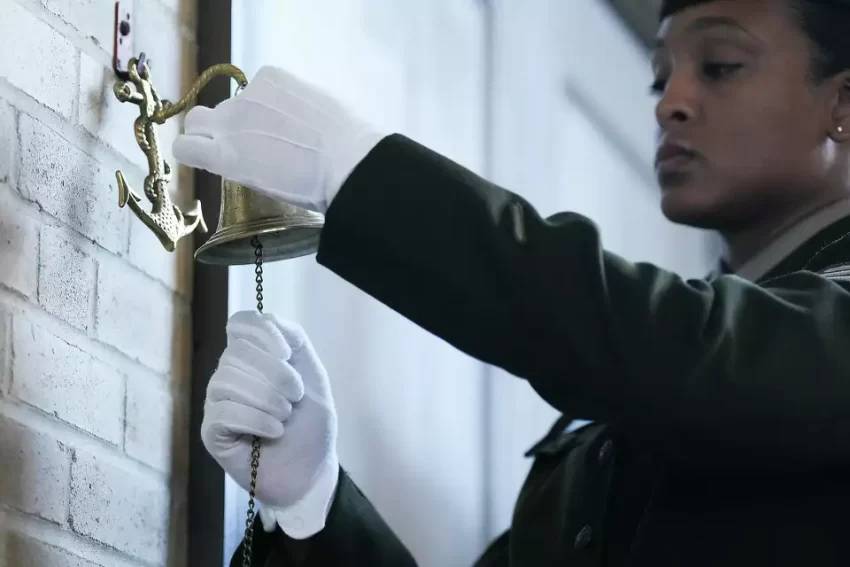
‘We apologize for editorials on Houston’s deadly 1917 riot’
By The Editorial Board, Houston Chronicle
Dec 10, 2023
When Harris County Sheriff Marion Hammond cut Bert Smith loose from a tree in September of 1917, the body of the 22-year-old Black man, a husband and a cook for an oil contractor, was still warm.
Hundreds of people, acting on accusations that Smith had sexually assaulted a white woman, wanted blood. Smith’s death certificate from the county clerk was clear: “hung by mob.” The sheriff, speaking to reporters the day after the Goose Creek lynching, was clear as well: “It would not have occurred had I got there 15 minutes sooner. The sheriff of this county is opposed to mob law of any kind.”
Hammond urged citizens to trust in law and order and was quick to pursue murder charges. Even so, fear grew in the Black community around Baytown, and many wondered if they’d all be driven out by mob violence. It was a moment in time when Ku Klux Klan parades were a routine sight and when news about the hanging appeared in the newspaper, as it did in the Houston Chronicle, beside a breezy write-up about an Eastwood dance hosting the KKK.
Smith’s murder is one of four documented lynchings in Harris County commemorated in the county’s Remembrance Project, which has adopted the wisdom of journalist and anti-lynching activist Ida B. Wells: “The way to right wrongs is to turn the light of truth on them.”
Many news organizations at the time, including this one, lacked the moral compass to do so.
Smith didn’t get a trial. Even if he had, justice wasn’t guaranteed, as evidenced by the scores of Black U.S. Army soldiers stationed here at Camp Logan who were arrested in the wake of the 1917 Houston Riot, which happened just a few weeks before Smith’s murder.
The notorious Aug. 23 riot led to the deaths of 16 white people, including five officers, and four Black soldiers. Indiscriminate killing in the streets is never justified, but fair accountability for any truly guilty parties was thwarted by an official response that can only be described as indiscriminate vengeance.
Little consideration was given to the events leading up to the riot, including police harassment of the out-of-town Black soldiers, some of whom were Northerners and others unaccustomed to Jim Crow-era segregation and subjugation that mandated color lines on everything from water fountains to street cars. Hours before the riot, a Black Army sergeant, Alonzo Edwards, was beaten and arrested after he confronted police who had dragged a young woman, Sara Travers, from her home in her nightgown, supposedly in pursuit of illegal gambling next door. When Camp favorite Cpl. Charles W. Baltimore tried to check on Edwards, police again beat the Black soldier and shot at him as he fled. Although he survived, word reached Camp Logan that he died, prompting fed-up soldiers to grab their guns and embark on an angry march toward downtown.
None of that mattered in court, or in this newspaper. Dozens of Black soldiers were represented in a sham trial by one man who wasn’t even a lawyer. They were swiftly condemned to death on the testimony of witnesses whose already biased accounts of the violence on a dark, rainy night were further muddled by a lack of visibility or compromised, in the case of some supposed participants, with promises of immunity. For their alleged crimes, 110 soldiers were convicted, 29 were sentenced to death and 13 were hanged in a rushed, clandestine affair on Dec. 11. Six more were hanged later. Public outcry spared 10 more soldiers from execution after presidential pardons.
Last month, the U.S. military attempted to make amends, overturning the convictions of 110 soldiers in a somber ceremony at the Buffalo Soldiers National Museum on Caroline Street. We wrote then that more entities should follow their lead and atone for historic wrongs.
Now, it’s our turn.
The day after the riot, in a front-page editorial, the Houston Chronicle beat the drum for military authorities to “act with vigor and determination,” arguing that there was no need for “finespun litigation” and that all the soldiers should be tried together. Set in all caps: “A COURT MARTIAL, A HOLLOW SQUARE AND A FIRING SQUAD WILL SETTLE THE MATTER ONCE AND FOR ALL.”
Reading these words today is a chilling reminder of the deeply entrenched role of racism in Houston’s past, including in this publication. Through a series of at least nine pieces in the month after the riot, Chronicle editorials used the violence and trial as an opportunity to excuse Houston’s “customs” — and encourage a reckless conviction not unlike the mob violence they sought to condemn.
The institutional voice of the Chronicle editorial board blamed the violence entirely on a lack of order at Camp Logan, including what it described as drinking, gambling and women-carousing. It had nothing to do, the newspaper insisted just hours after the riot, with any “trouble” between white Houstonians and Black soldiers. Black people simply required a more severe kind of discipline, the board argued. “[T]he negro temperament is such as to require absolutism on the part of those who command,” lest Black soldiers be led to believe that “the government is in sympathy with their arrogance and impudence toward white people and civilian authorities, but especially in the South.”
It was an extreme position, even for the time. Indeed, when the Houston Post, a rival newspaper, asserted a widely held opinion that Black soldiers from the North simply shouldn’t be stationed in the South — a tacit acknowledgment, perhaps, that Southern laws and customs were inhospitable to Black people — the Chronicle scoffed, branding its competitor “demure” and “lady-like.”
Yes, “laws and customs” differed in the South, the Chronicle board wrote the following day, but “[t]his segregation is a means of protecting both races, and was instituted for the maintenance of law and order.” Editorials gave little acknowledgment to violence, threatened and otherwise, that maintained the oppression of Houston’s Black communities on a daily basis. Streetcars, in particular, became a battleground, even before the out-of-town Black soldiers arrived and reportedly began pushing back on the color line, occasionally removing signs indicating where Black people could sit. From 1903-1905, Black Houston residents boycotted the system in protest. At one point, the streetcar company even lobbied City Hall to overturn the ordinance requiring segregation, but the city refused.
With the soldiers’ guilt predetermined, the Chronicle editorial board agitated for broad, harsh punishments. When a civil inquiry board released its own “impartial report” of the riot and recommendations to the city, editorials used it to clear Houston and its police officers: “[W]e feel that the whole country has already acquitted Houston of any and all responsibility.” The board briefly acknowledged the police beating of the Black sergeant that had sparked outrage before the riot, but dismissed it as “an irritating detail.” After all, the board wrote, “the spirit of mutiny and murder was already afoot.”
Opposing voices, meanwhile, were stifled. But the stakes were clear to Black residents, that they could be punished in their own way, too. The day after the riot, the Chronicle published a statement from the secretary of the Houston Negro Business League admonishing Black Houstonians to, “Stay off the streets…Talk as little as possible about this regrettable and horrible happening.” Keep a low profile, J.J. Hardeway promised, and white citizens and officers would protect them.
Today, this editorial board acknowledges and deeply regrets the role the Chronicle played in the deadly miscarriage of justice that followed the 1917 riot. We offer our sincere apology, not just for coverage of the riot itself but for the board’s defense of racist policies that had long fed inequality and stoked fear and animosity between whites and communities of color.
Tuesday, Harris County offered an official apology as well for the events that happened “under the watch” of its government and promised to create a more equitable justice system. A Houston Police Department spokesperson told us Saturday that Chief Troy Finner plans to announce his own apology for the events that helped spark the riot.
Though the city acknowledges one of the most horrific events in its history in a small plaque commemorating Camp Logan in an out-of-the-way corner of Memorial Park, city leaders have not officially owned up to the racist landscape that helped set the stage for the violence.
There are stories from our past that will never see the light. But with the stories we do have, and editorials, we must illuminate as much truth as we can — to learn, to heal and to progress in our proud, dynamic city. This editorial board will do our part.
To subscribe at no cost, please send an email to journal-isms+subscribe@groups.io and say who you are.
Facebook users: “Like” “Richard Prince’s Journal-isms” on Facebook.
Follow Richard Prince on Twitter @princeeditor
Richard Prince’s Journal-isms originates from Washington. It began in print before most of us knew what the internet was, and it would like to be referred to as a “column.” Any views expressed in the column are those of the person or organization quoted and not those of any other entity. Send tips, comments and concerns to Richard Prince at journal-isms+owner@
View previous columns (after Feb. 13, 2016).
View previous columns (before Feb. 13, 2016)
- Diversity’s Greatest Hits, 2018 (Jan. 4, 2019)
- Book Notes: Is Taking a Knee Really All That? (Dec. 20, 2018)
- Book Notes: Challenging ’45’ and Proudly Telling the Story (Dec. 18, 2018)
- Book Notes: Get Down With the Legends! (Dec. 11, 2018)
- Journalist Richard Prince w/Joe Madison (Sirius XM, April 18, 2018) (podcast)
- Richard Prince (journalist) (Wikipedia entry)
- February 2018 Podcast: Richard “Dick” Prince on the need for newsroom diversity (Gabriel Greschler, Student Press Law Center, Feb. 26, 2018)
- Diversity’s Greatest Hits, 2017 — Where Will They Take Us in the Year Ahead?
- Book Notes: Best Sellers, Uncovered Treasures, Overlooked History (Dec. 19, 2017)
- An advocate for diversity in the media is still pressing for representation, (Courtland Milloy, Washington Post, Nov. 28, 2017)
- Morgan Global Journalism Review: Journal-isms Journeys On (Aug. 31, 2017)
- Diversity’s Greatest Hits, 2016
- Book Notes: 16 Writers Dish About ‘Chelle,’ the First Lady
- Book Notes: From Coretta to Barack, and in Search of the Godfather
- Journal-isms’ Richard Prince Wants Your Ideas (FishbowlDC, Feb. 26, 2016)
- “JOURNAL-ISMS” IS LATEST TO BEAR BRUNT OF INDUSTRY’S ECONOMIC WOES (Feb. 19, 2016)
- Richard Prince with Charlayne Hunter-Gault, “PBS NewsHour,” “What stagnant diversity means for America’s newsrooms” (Dec. 15, 2015)
- Book Notes: Journalists Follow Their Passions
- Book Notes: Journalists Who Rocked Their World
- Book Notes: Hands Up! Read This!
- Book Notes: New Cosby Bio Looks Like a Best-Seller
- Journo-diversity advocate turns attention to Ezra Klein project (Erik Wemple, Washington Post, March 5, 2014)

